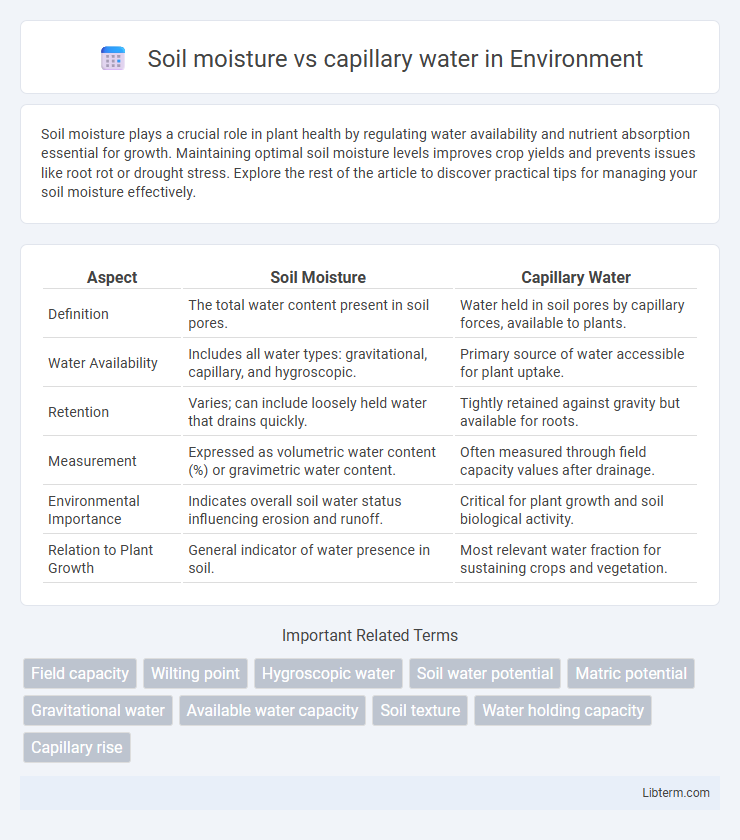Soil moisture plays a crucial role in plant health by regulating water availability and nutrient absorption essential for growth. Maintaining optimal soil moisture levels improves crop yields and prevents issues like root rot or drought stress. Explore the rest of the article to discover practical tips for managing your soil moisture effectively.
Table of Comparison
| Aspect | Soil Moisture | Capillary Water |
|---|---|---|
| Definition | The total water content present in soil pores. | Water held in soil pores by capillary forces, available to plants. |
| Water Availability | Includes all water types: gravitational, capillary, and hygroscopic. | Primary source of water accessible for plant uptake. |
| Retention | Varies; can include loosely held water that drains quickly. | Tightly retained against gravity but available for roots. |
| Measurement | Expressed as volumetric water content (%) or gravimetric water content. | Often measured through field capacity values after drainage. |
| Environmental Importance | Indicates overall soil water status influencing erosion and runoff. | Critical for plant growth and soil biological activity. |
| Relation to Plant Growth | General indicator of water presence in soil. | Most relevant water fraction for sustaining crops and vegetation. |
Introduction to Soil Moisture and Capillary Water
Soil moisture refers to the water content present in soil pores, essential for plant growth and microbial activity. Capillary water specifically denotes the water held in small pores of soil by surface tension, making it readily available for root absorption. Understanding the distinction between total soil moisture and capillary water helps optimize irrigation practices and improve agricultural productivity.
Definition of Soil Moisture
Soil moisture refers to the amount of water contained within soil pores, essential for plant growth and microbial activity. It includes various forms of water, such as gravitational water, capillary water, and hygroscopic water, with capillary water being the moisture held in small soil pores available for plant uptake. This dynamic balance of soil moisture influences irrigation practices, soil health, and crop yield efficiency.
What is Capillary Water?
Capillary water refers to the water held in soil pores by surface tension, making it available for plant roots to absorb. Unlike gravitational water, which drains quickly through large soil pores, capillary water remains in the micropores, providing essential moisture for plant growth. Soil moisture content heavily depends on the balance of capillary water retained in the root zone, influencing agricultural productivity and irrigation management.
Forms of Water Present in Soil
Soil moisture primarily consists of water held in the soil pores, which includes capillary water that occupies the small pores and is readily available for plant absorption. Capillary water forms a thin film around soil particles, creating an essential reservoir for root uptake and microbial activity. Unlike gravitational water that drains quickly, capillary water remains suspended due to soil surface tension, playing a critical role in maintaining soil water holding capacity.
Differences Between Soil Moisture and Capillary Water
Soil moisture refers to the total water present in the soil, including gravitational, capillary, and hygroscopic water, whereas capillary water specifically denotes the water held in the soil pores against gravity, available to plants for absorption. Capillary water is retained in micropores due to surface tension, facilitating root uptake, while soil moisture encompasses a broader range of water types including water that drains rapidly and is not accessible to plants. The primary difference lies in availability and retention; capillary water stays within the root zone and supports plant growth, whereas other forms of soil moisture may be transient or bound too tightly for uptake.
Factors Affecting Soil Moisture Retention
Soil moisture retention is significantly influenced by soil texture, organic matter content, and pore size distribution, which determine the availability of capillary water crucial for plant uptake. Soils with higher clay and organic matter hold more capillary water due to smaller pores and increased surface area, enhancing water retention against gravitational forces. Environmental factors such as temperature, soil compaction, and vegetation cover further affect the dynamics of soil moisture and capillary water availability.
The Role of Capillary Water in Plant Growth
Capillary water, retained in the small pores of soil, is the primary source of moisture accessible to plant roots, facilitating essential nutrient absorption and cellular functions. Unlike gravitational water that drains quickly, capillary water maintains optimal soil moisture levels crucial for seed germination and sustained plant growth. Its availability directly influences root development, photosynthesis efficiency, and overall crop yield.
Methods for Measuring Soil Moisture and Capillary Water
Soil moisture measurement methods include gravimetric analysis, time-domain reflectometry (TDR), and neutron scattering, each providing precise data on water content in various soil layers. Capillary water, crucial for plant uptake, is often assessed using tensiometers and pressure plates that determine water tension and availability in soil pores. Advanced techniques like dielectric sensors and infrared thermography offer real-time monitoring of both soil moisture and capillary water dynamics for improved agricultural management.
Importance of Managing Soil Moisture in Agriculture
Effective management of soil moisture is crucial for optimizing crop growth, as it directly influences the availability of capillary water, which plants absorb through their root systems. Capillary water, held within the micropores of soil, provides essential hydration and nutrients, maintaining soil structure and promoting healthy root development. Advanced irrigation techniques and soil moisture monitoring ensure precise water delivery, enhancing water use efficiency and improving agricultural productivity.
Conclusion: Optimizing Water for Healthy Soils
Soil moisture primarily refers to the total water content available in the soil, while capillary water is the portion retained in small pores and readily accessible to plant roots, playing a critical role in plant hydration. Optimizing the balance between soil moisture and capillary water enhances water retention and promotes nutrient absorption, leading to healthier soil ecosystems and improved crop yields. Strategic irrigation and soil management practices that maintain this balance ensure sustainable water use and soil vitality.
Soil moisture Infographic

 libterm.com
libterm.com